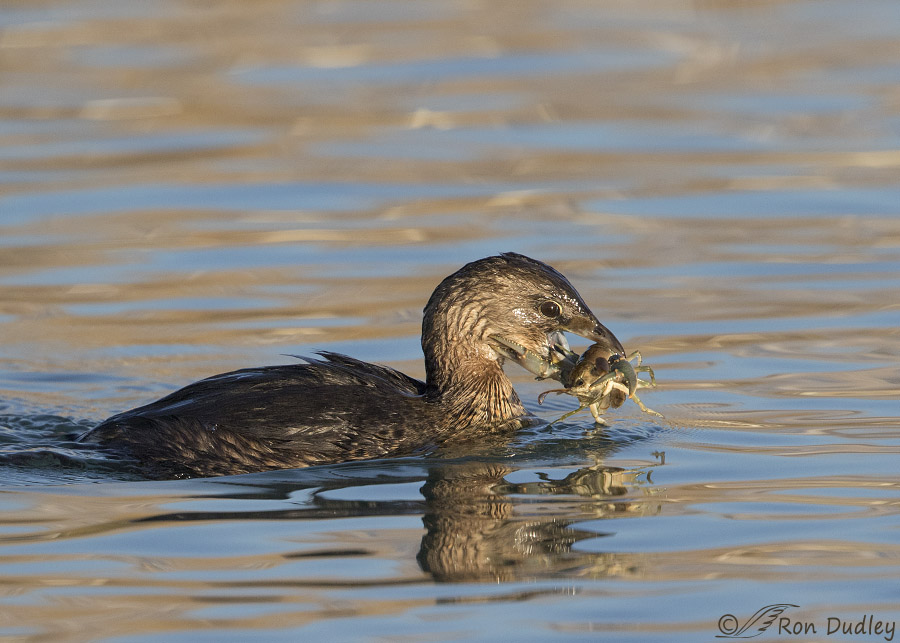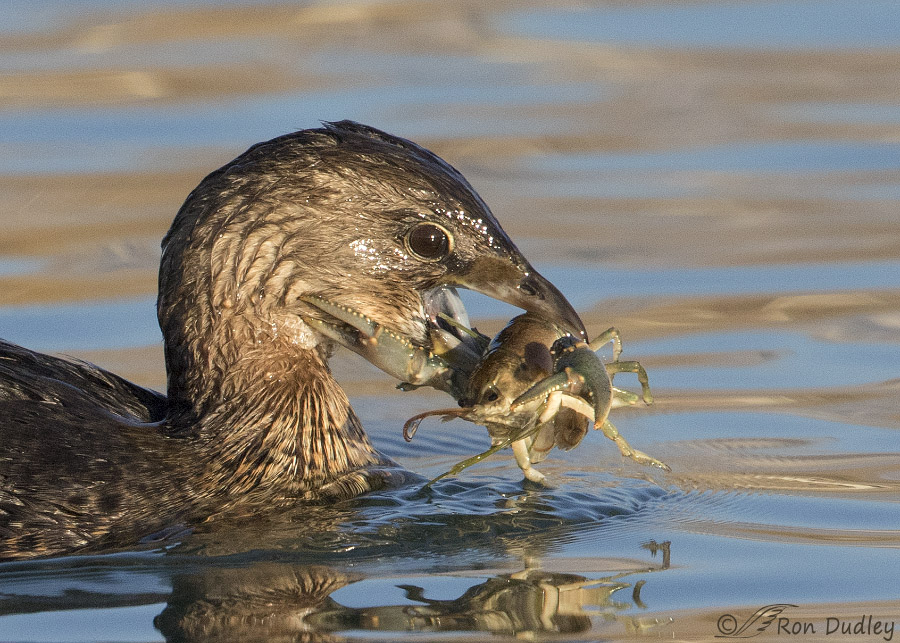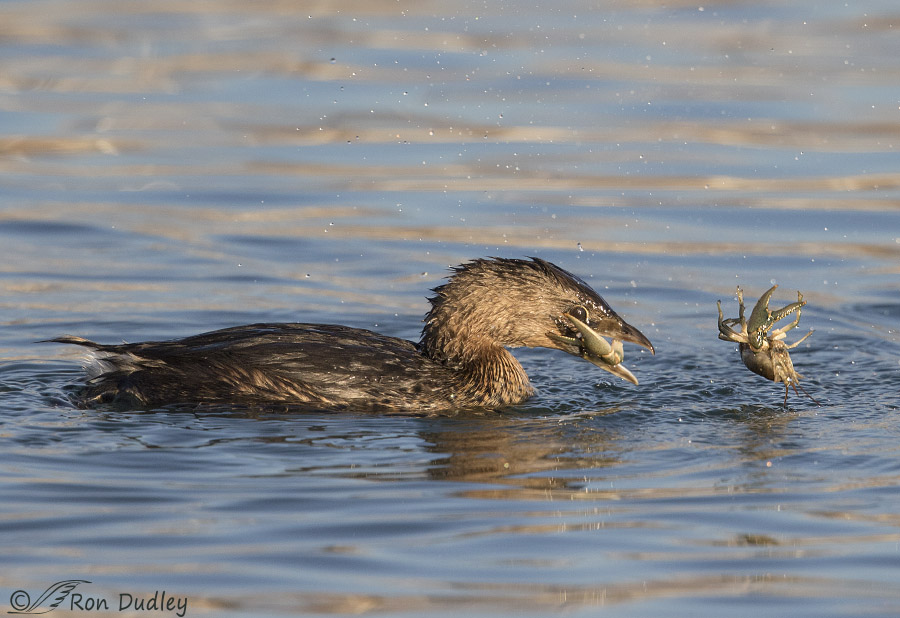I’ve photographed this feeding behavior before but those photos have never been this clear and detailed.

1/2500, f/6.3, ISO 800, Canon 7D Mark II, Canon EF 500mm f/4L IS II USM + EF 1.4 III Extender, not baited, set up or called in
The Pied-billed Grebes at a pond near my home are really chowing down on crayfish recently. In my experience with this species at other locations they overwhelmingly prefer to eat fish but at this pond their prey is nearly always crayfish (crawdads if you prefer). I’ve documented that preference many dozens of times in recent weeks and I do have some interesting photos of it. But due to a variety of factors including poor light angle, distance from my subjects and the incredible speed of these small birds as they manipulate and shake their prey I’ve never been able to get really clear and detailed shots of the portion of the behavior I’m most interested in – the removal of the claws before swallowing what’s left of the crayfish.
But yesterday I did, with this grebe and this crayfish. The grebe was close, the light angle was good, the bird didn’t turn its back on me during much of the frenzied feeding activity and I had (just) enough shutter speed to freeze the action.

A tight crop of the previous image allows us to see much better detail. The still struggling crayfish is being held securely in the grebe’s beak as it attempts to defend itself with its right claw (beneath the chin of the bird). For some reason the position of the left claw isn’t really clear to me but as you’ll see in the next photo it has to be there somewhere.
This may be the first time I’ve seen the tongue of a Pied-billed Grebe this clearly.
Crayfish claws are capable of inflicting serious pain and even damage to a bird this size so the grebes are extremely leery of them. Cornell’s Birds of North America Online includes a detailed account of typical Pied-billed Grebe feeding behavior when it comes to dealing with those claws, including the following excerpt:
- “Removes larger claws by holding appendage in bill just behind claw, and vigorously shaking until claw breaks off. Swallows crayfish tail first; remaining appendages fold alongside prey body, facilitating swallowing”.
And the grebes always seem to follow that script to the letter. Immediately after this photo was taken the grebe dipped the crayfish into the water in order to grasp one of the claws in its bill and then four frames later…

1/2500, f/6.3, ISO 800, Canon 7D Mark II, Canon EF 500mm f/4L IS II USM + EF 1.4 III Extender, not baited, set up or called in
it violently shook the crustacean which “amputated” the claw and sent the now one-clawed crayfish flying across the water’s surface. I’ve never seen a grebe swallow one of the amputated claws so I presume they discard them. Immediately after this shot was taken the grebe retrieved the crayfish, removed the other claw, and then swallowed the little lobster-wannabe.
Because I’m so fascinated by bird behaviors I was happy to get these photos but they’re the only interesting shots I got during that 75 minute session at the pond. This bird and a chance encounter with good friend and fellow bird photographer Deedee OBrien (Deedee and I go way back to our days working with Terry Tempest Williams at the Utah Museum of Natural History in the ’80s so it’s always a joy to see her) were the only high points of my time at the pond.
I was delighted with both.
Ron


Ron, your posting made me curious about crayfish in Utah. So, I googled this subject and found that there is one native species – pilose [pacifastacus gambelii]. There are 2 invasive crayfish species: northern and Louisiana. You need a fishing license to catch them and Utah Fish and Game have some tight controls. [You probably already know this].
Knowing this, I’m not about to get a license and go fishing for them for dinner!!! The Grebes can eat all they can catch!!!
The Pilose male is 1.1″ and the female is 1.6″. The crayfish in your photos look bigger than that, but it is hard to tell.
Sorry I got long-winded, but it is always fun to explore information that you include in your blog! I guess it brings out the ‘student’ in me!!!!
Alice, I used to see folks catching them for obvious food use at Strawberry Reservoir back in the 70’s. I don’t think you had to have a license to catch them back then.
A lot of things have changed since back then…sigh.
The eye and mind are weird for sure — I noticed the left claw right off, but didn’t see the right one until I read your description! These are great shots, Ron! Glad you weren’t totally skunked by birds or people.
Patty’s second comment made me think of the song about the old lady who swallowed a bunch of stuff — There was an old Pied-billed who swallowed a mudbug that wriggled and tickled until it went “Glug”…
Marty, I see the immoveable half of the claw but the other half isn’t where my brain tells me it should be. Go figure…
It’s fascinating to be able to see how the Grebe handles a crawfish up close. I’m glad you were able to catch that behavior so well.
Thank you, Susan.
The lengths that some people/birds have to go to for a good meal.
All in all, despite being partially skunked, it sounds like a wonderful day. For you and the grebe anyway.
Overall it was a good day, EC. Almost struck out though…
Nothing like being torn limb by limb……nature is not easy.
It sure isn’t, April…
Tricky visuals are something I’m very familiar with…saw a cute little gnome recently which disappointingly turned out to be a fireplug….
Check your glasses…or get some. Left claw is very visible and open for action in first frame…how to make out at first, but definitely there….Eagle Eyes McPherson would spot it in a heart beat…..
I would think those pointy legs remaining would still be pretty uncomfortable to swallow….especially sine the poor, old crayfish is still alive when it goes down….
Glasses checked. Still doesn’t work quite right…
Left claw is right under tip of bill…easier to see if image is enlarged…it’s coming right at you..right one is gone…..
Great shots Ron, excellent behavior images.
Thanks for sharing.
What a terrific series! Interesting (to me anyway) is just how wet the Grebe’s feathers are in the process of declawing “…the little lobster wannabe.” And there’s a right-on-target description!! Evidently, I expect their feathers to be closer to ducks on the waterproof scale.
While living in Slidell, LA, I came to appreciate crawfish boiled in Zatarain’s crab boil (among a bunch of other Cajun dishes). Zatarain’s is a flexible seasoning that can be used for lots of different things, including getting rid of fire ants when poured hot over the mound when you’ve finished cooking with it! AND it comes in a muss-free bag. Anyway, those little lobster wannabes are tasty treats, even though they require a lot of work to get there–both for the Grebes and us. LOL!
Delighted you could meet up with an old friend. That’s one of the true joys of life!
I noticed those soaked feathers too, Laura – that’s apparently why we don’t say “water off a grebe’s back…”.
HAHAHA! But I bet those feathers dry pretty darn quickly, too!
Marvelous behavioral shots Ron!
Charlotte
Thanks, Charlotte.
VERY good shots, Ron. It appears to me that the base of the left claw is held next to the body of the crawdad by the beak of the grebe so it really can’t “reach out and touch him” ? Glad you encountered and “old friend”………
Glad you encountered and “old friend”………
You may be right about that claw but for some reason my brain can’t make heads or tails of it because I can’t see the lower part of the claw where my brain tells me it should be. That happens sometimes… Thanks, Judy.
The bottom claw is running right along it’s face with the larger sticking out to the side…….. Know the feeling!